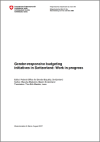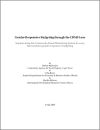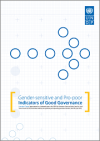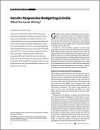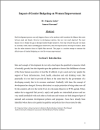FOUND 115
The first debates on gender-responsive budgeting initiatives emerged in Switzerland in 1994, The choice of methods for conducting gender-differentiated analyses and the means by which they are conducted have been informed, and continue to be informed, by the relatively early emergence of gender-resp
The paper suggests how the Community-Based Monitoring System (CBMS), developed and implemented in 14 countries over the last ten years with financial support from the Canadian International Development Research Centre (IDRC), can be used to facilitate gender-responsive budgeting (GRB) at the local l
This paper was prepared as a background to the UNDP Oslo Governance Centre and Indian Council for Social Science Research (ICSSR) International workshop on engendering and empowering governance indicators, New Delhi, April 2005.
The article examines the two main strategies adopted by the Government of India for institutionalizing gender responsive budgeting to highlight what has gone wrong and what needs to be fixed in order to achieve better outcomes for women.
This publication supports the design and formulation of Gender Sensitive policies and budgets in the Health Sector.
The Health Rights of Women Assessment Instrument (HeRWAI) is a tool developed by the Humanist Committee on Human Rights (HOM) in 2006 to enhance lobbying activities for better implementation of women's health rights.
This synthesis paper examines the evolution of efforts to address domestic violence in Latin America. In the outset, the authors elucidate the methodological dilemmas involved in collecting data on domestic violence.
This synthesis paper examines the evolution of efforts to address domestic violence in Latin America. In the outset, the authors elucidate the methodological dilemmas involved in collecting data on domestic violence. The paper discusses some of the outcom
This paper is an attempt to measure the effectiveness of Gender Budgeting as a tool for women empowerment. In recent years, Gender Budget Initiatives have emerged as an effective way to bridge gender gaps.
This review carried out under the UNIFEM's programme entitled "Integrating gender responsive budgeting into the aid effectiveness agenda", provides an analysis of how gender-responsive budgeting work has engaged with development planning instruments, national budgeting processes and aid modalities i
